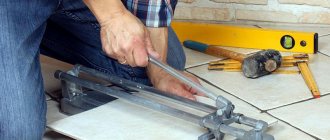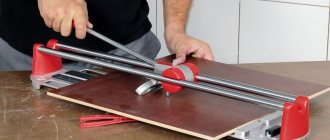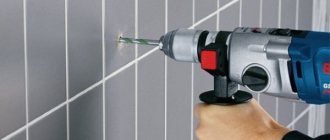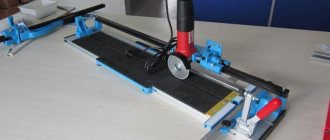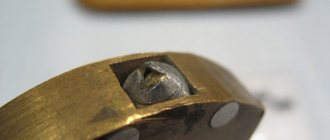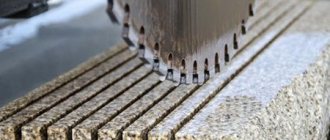Varieties of facing material and features of its various types
The cutting method depends on the type of facing material. The most important thing in this matter is not only the material, but also the role that is assigned to each tile in the composition. Tiles are usually produced in collections - these are sets that are thought out in terms of color and pattern. Most collections consist of several required elements.
- Background tiles usually do not have designs. Collections may contain several tiles of different colors. It is better to cut tiles in places where the background is uniform, so the cut tiles will not be so noticeable.
- Borders are small elements that separate large color arrays of tiles, often they have a rectangular format. If possible, cutting curbs can be avoided if these elements do not fit the walls.
- Decorated tiles are a type of tile with a pattern or relief image. It is better to immediately avoid cutting tiles with decor. To do this, at the laying stage, the tiles with decor must be taken to the central places of the room. Also, it is not recommended to place tiles with decor under the ceiling or near the floor.
Laying tiles without preliminary layout increases the number of cut elements. If you plan the location on paper, you can avoid a large number of scraps and scraps.
- Floor tiles are usually thicker than wall tiles, making them more difficult to cut. In addition, large-format tiles are more often used on the floor; unevenness when cutting is also noticeable.
Floor tiles have to be cut more often if the corners in the room deviate from 90 degrees. For this reason, to lay tile coverings on the floor, the walls in the room must be level.
Junction places
The complexity of the cut depends on the location of the tile relative to other elements. It is advisable that in these places there are no important and expensive tiles (borders, decor) - this point can be solved by preliminary layout of the elements. For example, curbs should not abut communications or sockets. In places where the tiles meet sockets, radiators or plumbing fixtures, complex cuts are made on the tiles (circular, semicircular cuts).
It is better to minimize the number of junctions in which tiles need to be cut at the planning stage.
Tile material
The thickness and strength of the material often depends on the material from which the tile is made. Some materials have a high density, so not every tool is capable of cutting them. Some materials require a delicate approach and can only be cut with specialized tools.
- Ceramic tiles are the most common type; they are covered with a decorative glazed coating on top. Ceramic tiles are divided into wall and floor tiles, the latter is usually thicker, which makes it more difficult to cut.
- Porcelain stoneware has a high density, which determines its low water absorption. Because of this, these tiles are often used for floors, wet areas and streets. It will be difficult to cut porcelain stoneware using improvised means; cutting is best done with an electric or manual tile cutter.
- Clinker tiles are a type of high-density cladding; they are used for exterior work (cladding, paving areas, etc.). For thick clinker, you will need a grinder or a water saw (electric tile cutter).
Glass cutter
A roller glass cutter is a cheap and convenient tool that is perfect for cutting small amounts of material.
Its main advantage is its ease of use:
- To cut a piece of tile, place it on a flat and hard surface, then make a mark on it;
- The next step is the actual cutting: run the glass cutter from the end of the tile towards you along the intended line, pressing on the surface;
- Breaking off a tile is not difficult: take a thin object, such as a pencil, and place it under the cut line, then press on the tile on both sides of the cut.
You can make this process easier with the help of a more advanced model - an oil glass cutter. The handle of this tool has a built-in reservoir into which the user pours a mixture of machine oil and kerosene. During cutting, the mixture flows onto the roller and thereby facilitates the process of cutting the material.
Cutting tiles without a tile cutter: methods and nuances
Ceramic or porcelain tiles are very hard facing materials, similar in many properties to glass. Therefore, the methods of cutting it will be similar. The same glass cutter, but you should immediately warn that not all material can be cut equally effectively even in this way.
For example, tiles with a relief structure will be a very difficult task and sometimes even beyond the capabilities of a glass cutter.
The main task when cutting is to ensure that the cutting side remains smooth and there are no chips. Often the cut edge is placed under a plinth or covered with vertical tiles, in which case you don’t have to worry at all, but feel free to take a grinder with a diamond cutting wheel. But you should be careful with this tool, as you can cut with a lot of chips.
Let's look at the most effective methods for cutting tiles without a tile cutter and with minimal waste. Regardless of what you use to cut or drill tiles, you should always be extremely careful and not make sudden movements. You can accidentally move the workpiece and break the thin element. It is especially dangerous when it is L-shaped and one side is thicker than the other.
It is also important to provide the necessary conditions for carrying out such work. They consist in securely fixing the material so that it does not vibrate or twitch during processing.
Recommendations
Before cutting, it is useful to soak the tiles in warm water for 40-50 minutes. (except porcelain stoneware), this will give a triple effect:
- the ceramics will soften and will be easier to cut;
- the number of chips will decrease;
- There will be less dust (when cutting with a disk).
It is not worth keeping the tiles in water for a longer time - they will deteriorate. When using an angle grinder, you can supply water to the cutting zone without a special device.
Craftsmen attach a hose to the tool casing with clamps and connect it to the water supply. A simpler option is to invite an assistant and arm him with the same hose or a spray bottle made from a plastic bottle.
Cooling with water allows:
- improve cutting quality through the use of a solid disc;
- prevent the release of dust.
When using an electric tile cutter with a bath under the work table, the water in it is often changed. Otherwise, large amounts of accumulated debris are captured by the disk, which leads to deterioration in cutting quality. If you don’t want to bother with this, you need to choose a model with running water supply.
Is it possible to cut tiles without a tile cutter?
Considering the many ways to cut ceramic and even porcelain tiles, the answer to the question is whether it is possible to cut tiles without using a glass cutter, we will answer directly, it is possible. But the quality of the cut will be different in all cases, which also depends on the hands of the master who will perform this procedure.
You should also stick to technology. For example, when working with hard facing materials and using an angle grinder with a disc, it is recommended to use water cooling. This will increase the cutting speed and quality significantly.
Some tips about forgotten technologies
Are you going to lay the tiles yourself? Please note that the process is very labor-intensive and will require certain experience from the contractor. Beginners should be given some practical advice: if you use a grinder to cut tiles without a tile cutter, then you should not make sudden movements, because the diamond wheel will damage the part that should remain clean.
Do you think it is possible to cut tiles without a tile cutter?
Cannot
Also follow safety precautions, always use personal protective equipment against dust for the respiratory system and eyes. Shards can very quickly and easily damage the cornea, and dust can clog the airways.
Alternative tools and their features
Let's look at the most popular methods of cutting ceramic or porcelain tiles with acceptable quality. These include:
- Grinder with a large disc . There are several types of these tools that can be used to cut ceramics. To do this, buy an appropriate diamond-coated disc. There are several varieties of them on sale, depending on the grain size and cleanliness of the cut.
- Jigsaw . This is a convenient and very practical tool with which you can make a clean cut, but for this, purchase a special tile file. Its advantages lie in its versatility, that is, it is possible to perform curved cuts with a large radius.
- Manual glass cutter . Suitable for cutting smooth glazed tiles.
- Drilling holes with a drill . This is a convenient method, but to obtain a high-quality end after cutting, you need to go through the area with additional grinding tools, for example, a file and sandpaper.
To make round holes in ceramics, a hole saw, a crown, or a ballerina drill are used. Radius bends with small turns are selected manually using tongs or pliers.
We also recommend watching - How to drill tiles in the bathroom: expert advice
Round holes
There are crowns that are designed to create circular holes in tiles. The maximum and minimum diameter of the finished hole when using crowns is quite small.
- The first value is three centimeters, the second is 8 cm.
- If you need a larger diameter, you can use a grinder or a ballerina drill.
- The crowns, as well as the grinder discs, have diamond coating.
Methods for cutting tiles without a tile cutter
Depending on the type of cut, there are several technologies for performing this task:
- Electromechanical - the process occurs using any tool with a crown, drill, disk, stone or other device. In one case or another, everything is done strictly to the line.
- Mechanical – cutting tiles without a tile cutter, namely without the use of electric tools. Based on physical strength and the use of hand tools. These include: glass cutter, pliers, forceps, file.
- Hydromechanical is a cutting method in which the tiles are separated into parts by exposing the area to a powerful jet of water with an abrasive mixture. The thickness of the cut is quite narrow, and the quality of the cuts is high.
Angle grinder grinder
Let's look at how to cut tiles without a tile cutter using an angle grinder. To do this you will need:
- A machine with a diamond wheel of appropriate grit.
- A flat, stable surface to perform work on.
- A ruler or pre-drawn line on the back of the tile.
- A backing for the tile so that it does not wobble or slide during cutting.
- It is advisable to connect a vacuum cleaner, because during operation a lot of dust will be generated.
Once the tile is stable, you can start cutting. You should start from the nearest edge and move the stone so that it hits the face covering. This way, chips will form only on the bottom, while the top will remain smooth. It is convenient to make cuts in the same way.
Jigsaw
Another handy tool for cutting tiles is an electric jigsaw. To use it, you need to purchase special stone files. The peculiarity of using this tool is that it can be used to make curved cuts.
By applying a ruler to the surface of the tile and moving along it, a fairly even cut is achieved, and the end remains with a slight roughness. To avoid chipping, point the saw teeth at the glazed surface and move the tool slowly.
To perform the work, you should use a durable table, securing the tiles to it with a wooden clamp, and the surface should be perfectly flat.
Stone file
Glass cutter or any pointed tool
This is the most ancient and quite effective method that is still used for cutting glass. With an experienced craftsman and a well-sharpened tool, the end is smooth without bevels or twists. The glass cutter essentially does not cut, but cuts, creating cracks in the upper layers of the tile.
After the strip has been drawn, the tile must be placed on a hard surface along the cut site and pressed onto the edge with a sharp movement. If the facing coating is hard enough, then the chip will be smooth, but if the ceramic is loose, then the unevenness will have to be removed with a needle file.
Recommended for use on wall tiles, limited to floor tiles. It is very difficult to break porcelain tiles this way.
Round holes
To cut round holes in ceramics or porcelain stoneware, you must use specially designed crowns. They are equipped with diamond segments or coating, which are used for drilling. The diameter of the hole can be any using such devices, ranging from 30 to 80 mm.
If you need to drill more for installation of electrical or plumbing components, then it is better to use a ballerina drill. It consists of a drill on a bracket in the center and two cutters, with regulation of their position relative to the center. A hole saw and diamond bits are also used for these purposes. The principle is the same.
Figured breaking out
Figured breaking in ceramics is not an easy task. To do this, you must first make many cuts with small increments from the end to the figured cut. The smaller it is, the more accurate the bend on the ceramic will be. The cuts are made slightly short of the main line. Afterwards, using forceps, each segment is carefully broken out and unnecessary ceramics are removed with small bites.
Depending on the diameter of the holes, tools and attachments are selected. Any tools with a rotating tip (drills, screwdrivers, hammer drills, hand rotators, etc.) are most suitable for making holes in tiles.
Note! The power of the tool does not matter, the rotation speed is more important. It is desirable that you can set a low rotation speed. Above 500 rpm is only detrimental to the cutting tool. Although the hole is made faster, the cutter gets very hot and fails faster. In addition, high rotation speed increases the likelihood of chipping along the edges of the hole.
Various attachments for drilling holes in tiles. Nozzles for small diameters (up to 15 – 30 mm):
- Special drills with one-sided acute-angled sharpening. The best option, but quite expensive. Lasts a long time, drills into almost any hard tiled surface;
- Spear-shaped drill bits for tiles. Cheap drills are the best option for one-time work. When used on simple tiles, they will last for several dozen holes;
- Drills with carbide tips (for concrete, stone, for hammer drills, etc.). Not the best option, but if necessary, you can make a couple of holes with them.
Large diameter nozzles:
- Crowns with various materials (diamond, corundum, tungsten carbide). They are considered professional tools and are expensive;
- "Ballerina." In the center is a spear-shaped drill; the location of the second cutter is adjusted by moving a rod secured to the central leg with a bolt. A cheap option that will allow you to cut several holes of different diameters.
Starting from a diameter of 50 mm, holes can be cut with a grinder. It is recommended to carry out all work wearing a protective mask or goggles.
Cutting with tongs and cutter
The technology consists of cutting off the main part of the tile with a cutter, like a glass cutter. Afterwards, using pliers, the cut shape is adjusted to the required profile. Finally, the roughness is cleaned up and final shaping is performed. If you try, you get the shape of a hole or cut with the given parameters.
For figured breakout, it is recommended (if possible) to apply a deep mark along the entire breakout boundary using any method. This will reduce the number of possible chips.
There is a special tool for breaking out - pliers with a wheel. But for one-time work it is not advisable to purchase a special tool. Therefore, you can get by with ordinary pliers.
The breaking technology is very simple. The pliers (or tongs) are strongly compressed, causing the material to crumble, or they are compressed and sharply turned (only far from the fault line, at least 5 mm). Small pieces break off. If you try to break off a large piece at once, you can ruin the whole job. A part may break off behind the line of marks.
Long, straight, narrow pieces across the entire tile are broken off by sharply turning the pliers to the side. Pre-clamp them along the line of the marks (a scratch, of course, must be applied). In this case, the entire length of the tile may not break off and the procedure will have to be repeated on the remaining part. Then the remaining sharp protrusions are also carefully broken off.
Using a sander to cut slabs
An angle grinder is the most common way to cut tiles without a tile cutter. With its help, you can obtain perfectly even pieces of material with exact dimensions for specific requirements.
It can also be used to trim the profile to the required value. To obtain a quality saw, you must use the correct blade. They are available with integrated teeth-segments made of a high-hard alloy and coated with diamond chips or slurry. The finer the crumb, the better the quality of the end.
Using a Hole Saw
A common method for making round holes for sockets, switches, junction boxes or plumbing equipment. It is a diamond nozzle with a centering drill. It has thickened walls, and on the cutting part there are cutting segments made of diamond or carbide.
The use of sprayed crowns is also practiced. The hole diameter can be up to 80 mm.
Waterjet cutting
A relatively new, but already very common method of cutting tiles and other sheet materials. The principle is based on the effect of a powerful jet of water of small thickness on the material, as a result of which there is no temperature effect on the workpiece, so it will not deteriorate and will not lose its qualities.
Cutting with water and abrasive ensures high quality and accuracy with minimal deviations from the specified parameters.
For the sake of fairness, we note that waterjet cutting of ceramic tiles is the aerobatics of processing porcelain stoneware, as well as hard stones. The cut is perfectly smooth, does not darken, and does not require sanding. Using this method, you can cut out any shapes you like and create artistic compositions from tiles. None of the other known methods gives such an excellent result.
- The principle of operation of such a tool is to supply a mixture of water and abrasive material under enormous pressure. The feed speed of such a mixture reaches 1 km per second, which is why this result is achieved.
- It is clear that such work requires special equipment. Waterjet cutting is performed on special machines, that is, on massive and rather expensive equipment. A similar machine can also be purchased and installed in a home workshop to perform very high-quality work for yourself, as well as to order. If you learn to work well on such a machine, you can earn good money from orders.
Significant advantages of waterjet cutting:
- Porcelain tiles up to 30 cm thick can be processed.
- Unsurpassed cutting quality.
- Performing cuts of any complexity.
- The edges of the cut have virtually no roughness.
- Using water for cutting and cutting eliminates the possibility of ignition and explosion of the surface being processed.
Waterjet cutting
When cutting ceramic tiles using waterjet cutting at home, you must strictly follow the instructions. And it, in turn, will be attached to the equipment. Accordingly, instructions for use for different equipment will be individual.
How to make a rounding?
Often, when finishing walls or floors with tiles, it is necessary to make a rounding on the element. To get it, you need to use figured cutting technology. It consists of small cuts at small intervals to the required bend line, slightly short of it.
Afterwards, using end cutters, small fragments are broken out and the bend is trimmed with small bites. You can finally bring the detail to mind using a needle file.
Using an electric tile cutter
This is an expensive professional tool that will cut any tile equally quickly, smoothly and accurately. With its help, you can cut straight and at an angle of 45 degrees, drill holes and recesses, as well as figured cutting. The cut strips are less than 5 millimeters wide. The edges of the cut are smooth, slightly rounded.
Some models work with tiles with one side dipped in water, others only require regular wetting along the cut. This method prevents the formation of dust.
The tool consists of a base, a knife and an electric motor, and the cutting process is as follows:
- Water is drawn into the pan at the level of the cutting disc so that it is lowered into it by 2-3 centimeters (for submersible models).
- The tile is clamped and slowly moves under the cutter along the markings. The force must be uniform to avoid chipping and jamming of the motor.
- To cut a corner, repeat the procedure twice along segments with the desired angle.
Like any similar tool, an electric tile cutter requires compliance with safety requirements and the use of protective equipment.
For high-quality work, you need to change worn out discs and water on time.
How to cut ceramic tiles with a nail?
- If there is no special tool for cutting tiles in the house, and at the same time there is a need for such work, how can you cut ceramic tiles? A regular nail may be suitable for this purpose.
- The nail must be at least 100 mm (one hundred square meters) and of appropriate thickness. Old Soviet steel nails are more suitable, but in any case, one nail is only enough for 5-7 slabs , then it needs to be replaced.
- And yet, you can only cut wall tiles with a nail, but not porcelain tiles.
The technique of cutting with a nail is not much different from similar work using a glass cutter or cutter:
- A line is drawn along the front side of the tile using a nail and a metal ruler (slat).
- The cut should be smooth and as deep as possible.
- You can make 1 more cut from the back side of the tile, but maximum accuracy must be observed.
- The tile is carefully broken along the cut line in the usual way.
- Most often, the cut line needs to be cleaned and sanded.
Figured carving
To go around pipes, sinks, toilets and door frames, it is necessary to cut semicircular cutouts. At home you can do this like this:
- Using a ballerina and a drill tripod. The diameter is limited by the rod and set manually. The resource of one device is enough for 20-30 holes in the tile.
- For bends of small diameters, you can use wire cutters. This method allows you to make not only semicircular cutouts. The cut should start from the very edge with a minimum step. Both of these methods require certain skills in working with the tool, but even in this case it will not be possible to achieve smooth edges; additional processing will be required.
